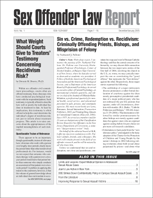Juvenile Sex Offending and Conduct Disorder
Author: Zachary Yeoman, Psy.D..; Sean P. Hiscox, Ph.D..; Philip H. Witt, Ph.D..
Source: Volume 22, Number 01, December/January 2021 , pp.1-6(6)

< previous article |next article > |return to table of contents
Abstract:
Juveniles who commit sex offenses are sometimes given leeway, assumed to be more treatable. Compared to adults, their sexually abusive behavior is less likely to reflect bad character, since their personalities, judgment, and ability for self-control are still forming, making them more malleable than adults. Yet, juveniles present significant concerns. Although estimates vary, depending on the source of data, a recent review indicates that juveniles commit anywhere between roughly 15% and 30% of sex offenses. In 2009 over 15,000 juveniles were seen in juvenile court for sex offenses. What causes juveniles to commit sex offenses? In this article, the authors address two areas: the developmental issues that can contribute to juvenile sexual offending and non-sexual conduct problems—diagnostically, conduct disorder—that can also cause juvenile sex offending. It considers how frequently conduct problems underlie juvenile sex offending; how often does a diagnosis of conduct disorder play a role in juvenile sex offending and how such a diagnosis affects risk assessment; and implications for treatment.Keywords: Forensic Evaluation; Megan’s Law Tiering and Relief; Adverse Childhood Experiences; Conduct Disorder; Assessing Reoffense Risk in Youth
Affiliations:
1: Somerset Psychological Group; 2: Somerset Psychological Group; 3: Somerset Psychological Group.